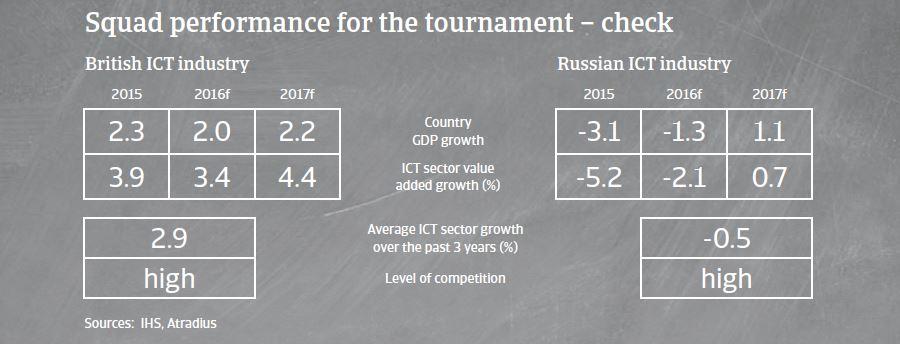An uneven match, given that the British ICT industry is doing rather well, while the Russian ICT sector is caught in a downturn, with many insolvencies.
European football championship 2016
Sector playing field: ICT industry

England: added value service is key
The general demand situation for ICT in the United Kingdom remains good. While demand for hardware products continues to decline (with shipments down 7.7% in 2015), however this is from a very high base, and IT products will continue to be required.
Many IT resellers continue to lessen their reliance on hardware sales by offering value added IT services. This enables them to secure medium- to long-term contracts, which provide them with a better visibility of revenues. Additionally, service activities tend to provide higher margins.
Competition continues to be fierce in the ICT sector, with minimal barriers to entry. ICT businesses not only compete on price but also on their product offering, as they try to differentiate their offering in order to preserve margins.
Most ICT companies finance their businesses with asset-based lending facilities. While businesses usually have a working capital deficit, they are able to leverage their debtor book in order to aid liquidity. With the bulk of the lending being asset backed and IT distribution/reselling not seen as a particularly risky sector, banks are generally willing to lend.Russia: a though match continues
The Russian electronics/ICT sector suffers from the difficult domestic economic environment. Major retailers reported shrinking revenues in 2015, with decreases of 10%-30%, depending on the region. In 2016 no rebound in demand is expected, with a further rouble devaluation having negative consequences on consumer demand. After decreasing in 2015, the margins of electronics/ICT businesses are expected to deteriorate further.
Many players left the market, but nevertheless the degree of competition is steadily growing, and consolidation in the industry is on-going. Price wars are still frequent amongst retailers as consumers have switched to cheaper B-brands. Some federal retail chains have taken advantage of this opportunity to gain additional market share in the currently difficult environment.
The gearing of major Russian electronics/ICT retail and distribution businesses is high, as they use banking facilities to finance working capital. The Russian bank sector is currently under pressure due to the difficult macroeconomic environment. However, businesses with a clean payment track record usually do not experience liquidity problems with banks.
Players to watch
England

Data centres and cloud computing are the areas that are anticipated to drive the sector forward, as we have seen a surge of investment within this area. However, British ICT businesses will face stronger competition from their European peers, mainly due to the strengthening of the pound.
The continued development of mobile apps and new technology (e.g. wearable technology) will continue to drive the sector forward.

Telecommunications is a slightly more difficult segment given the dominance of a few large players in both airtime and handsets. Mobile telecommunication retailers represent a slightly higher risk than other ICT segments. Margins remain slim due to the dominance of the key players, meaning that distributors are often looking at margins of about 3%.
Russia

Currently all Russian electronics/ICT subsectors face major troubles, especially those retailers and wholesalers that trade in foreign currency.
Consumer electronics is the most difficult segment, which is severely affected by the on-going slump in private consumption. Telecommunications suffers from the weak rouble and currency volatility in emerging markets. Only the IT segment shows less deterioration in demand.
Major strengths and weaknesses

British ICT industry: strengths

Russian ICT industry: strengths
- Importance IT plays for most industry sectors
- Technology developments maintain high demand
- Supply chain finance / bank finance is prevalent in the industry
- Investment in data centers / cloud computing continues to gather pace
- Generally attractive for investors
- Low level of insolvencies
- Despite the current troubles the Russian market has large potential, with high pre-crisis growth rates
- E-commerce continues to grow, with the increasing number of internet users
- Tax authorities are tightening control over the sector, which cleans and consolidates the market

British ICT industry: weaknesses

Russian ICT industry: weaknesses
- High levels of competition
- Hardware sales continue to decline
- Massive decrease in consumer demand, with no rebound in the short-term
- Restrictive consumer credit landing by Russian banks has a negative impact on demand
- High level of payment delays and insolvencies
- Currency volatility hurts ICT importers and retailers
- Lack of market transparency, with many grey imports
Fair play ranking: payment behaviour and insolvencies
British ICT industry
On average, payments in the British ICT sector take around 60 days.
Payment experience is good, and the level of protracted payments is low.
The number of non-payment cases has not increased in the last twelve months, and this positive trend is expected to continue.
The level of ICT insolvencies is low, and this rather benign environment is expected to remain unchanged in 2016.
Russian ICT industry
Depending on the level in the supply chain and market leverage of businesses, payment duration in the industry ranges between 30 days and 120 days.
Non-payment notifications have increased in 2015, and this negative trend is expected to continue in the coming months.
Insolvencies have increased in the last twelve months, and further increases are expected in the coming months.
Most cases of late payments and business failures are seen in the segment of regional small-and medium-sized electronics/ICT wholesalers and retailers; especially with businesses that were ill-prepared for the drop in consumer demand, or which did not hedge against foreign exchange risks and had a high gearing.

